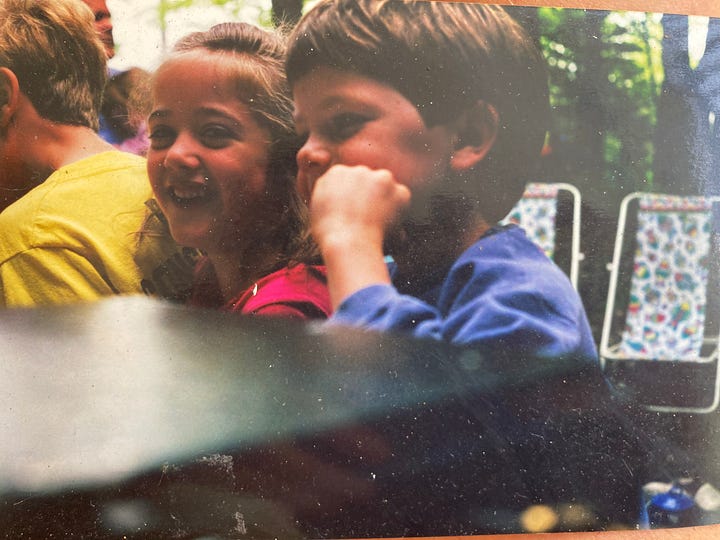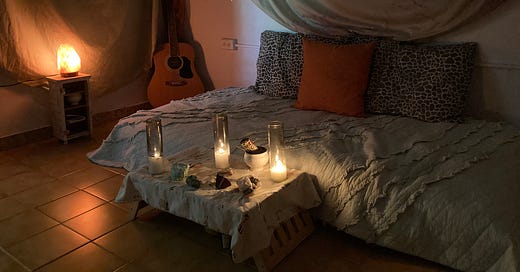Back in elementary school, there were a few kids in my class who were always “hurt.” One week they’d have their wrist wrapped in gauze and the next, they’d have crutches (but you’d catch them walking normally when they thought no one was looking). They were always crying at “nothing” on the playground and often had to leave school early because their stomach hurt.
The rest of us quickly got wise to their games. We’d talk behind their backs about how they were faking it. They were dramatic, a cry baby. They just want attention, we said.
We watched how our teachers dismissed them, too. Rolled their eyes as they walked in with an ankle brace for the third time that school year.
Brutal.
How early on I learned that so few of us are brave enough, have the capacity, to really hold another in their pain!
Obviously, these kids were struggling. I can imagine neglect, divorce, death, addiction… I’m guessing that no one was there to listen, to support, to even acknowledge the pain they were experiencing. Maybe they themselves didn’t even know what was wrong.
They just knew they didn’t feel okay and they needed someone to see.
So they tried communicating their pain in a way our culture tends to take more seriously — via physical wounds. (And I suspect in some cases, the emotional pain caused the physical symptoms, like consistent inexplicable stomach aches.)
But we felt they were trying to pull something over on us and we didn’t like it. More than that, we (the adults especially) were afraid of the Big Scary Feelings under all that gauze.
With the exception maybe a few parents and teachers I’m not remembering at the moment, the consensus was:
These kids are too sensitive.
and/or:
These kids are weak.
and/or:
They are liars and their pain is fake.
… all of which typically led to the conclusion:
Make fun of/reject/exile them.
How early on I learned that so few of us are brave enough, have the capacity, to really hold another in their pain! That vulnerability is so often perceived as “weakness” and leads to banishing. I dared not be that person who cried at recess unless something really bad happened. And even then, I’d try to suck it up and be tough.
I got really good at pretending I was okay. And as I got older, I learned that the key to successfully hiding my emotions from others was to first hide them from myself. Which meant that during some of the hardest times in my life, I didn’t even know I was miserable.
Four years into a relationship with a man who struggled with depression, for instance, I thought I was just fine — despite that I was constantly neglecting myself and my needs as I tried to “fix” him (a compulsion that sucked for both of us). I thought I could just keep on doing that indefinitely with no ill effects.
It was a close friend who finally woke me up. She knew my then-boyfriend well, knew he’d been isolating and even avoiding work for months. She’d been to our house recently, had felt the heaviness.
I learned that the key to successfully hiding my emotions from others was to first hide them from myself.
One early spring day, we drove to the ocean and had a picnic. As we plodded through the sand on the way back to my car, she said something like, “You always seem like you have it together, like you’re ‘fine,’ but I know you can’t actually be fine right now...”
Sometimes you gotta trust a friend is seeing something you can’t.
When I entertained the idea that maybe I wasn’t fine, I started noticing things. Like that I was nearly paralyzed in my writing. I remember pulling Anne Lamott’s Bird By Bird from the shelf one morning, clinging to her words about writing shitty first drafts, trying to work up the courage to open my laptop. One relatively short article I was working on around that time took me a whole year to finish.
My self-esteem had fallen off a cliff.
I also remember making a mental inventory.
I have close friends,
A comfy house,
Sweet cats;
I’m growing in my career,
I’m eating well and exercising…
Despite all that, I just didn’t feel like me. I lacked this joy and buoyancy I used to carry.
Okay, maybe I wasn’t fine. I found a therapist and made an appointment.
As our conversations started to crack me open, I cried nearly every day for a couple months. (Seriously.) It often hit me early in the mornings, when I’d go to a playground near my house to jump rope. When I finished my workout, somehow I’d end up sobbing on a bench. I started to see how deeply Not Okay I was.
Three years later, I’m still out here practicing feeling my feelings. I’m trying to release some really old hurts I’ve minimized, denied, exiled — and also grieve losses I didn’t realize were losses at the time.
It’s a lot.
So much that I had to create an actual space for it.
Thanks to my spiritual guide/therapist and my former roommate, Lilli, I now have a room in my house where I can go to feel.
We call it the Womb Room.
It has soft sheets draped from the walls, one with baby sleeping foxes and deer; another with soft purple orbs I tie dyed. There’s a salt lamp that emits a pink glow and a mattress on the floor covered with pillows and blankets. And in front of it, a table with candles, bits of sage, rosemary and sweetgrass, stones and crystals.
It’s like my grown-up playroom (or more like “feel/cry/healroom”).
I go in there to meditate, to journal. I lay on the bed and practice yoga nidra, getting more in touch with the sensations of my body. When I’m writing something especially heavy, I take the laptop in. (I was in there a lot while working on this piece.)
“Why don’t you create a safe space to actually face the shit?”
And when shit happens and I feel tears coming, rather than “shaking them off,” I pull up a handpan song on youtube and head into the Womb Room. I curl up in fetal position and really go there. When the pain is really old, sometimes I stroke the hair above my ear, helping that little kid in me feel safe enough to let it all out.
Before this was the Womb Room, it was a windowless box both Lilli and I detested, were a bit afraid of, even. We had decided we would use it as a giant closet — a perfect place to throw all the stuff we didn’t want to deal with and shut the door.
I mentioned it to my spiritual guide-therapist (because my roomie and I had had a bit of conflict over who would sleep in which of the other two bedrooms — one which is small, and the other somewhat exposed to the road). She didn’t love our conclusion to make the windowless bedroom the stuff-banishing room.
“Why don’t you do something different?” she asked.
Different than the strategy passed down for generations, learned at home and at school: exile the ugly, scary stuff.
She shared her vision of the warm, comforting darkness of a womb where we could deal with the stuff we’d rather shut the door on.
Why don’t you create a safe space to actually face the shit?
The Womb Room is where I’m starting to undo the conditioning that says that being sensitive is weak; that I should just exile my pain and suck it up. It’s where I practice coaxing myself to be vulnerable, rewiring to build a sense of safety with my own emotions.
It’s where I’m learning what I need to be able to go to those darkest places: to hold myself, to feel held.










You never cease to amaze me! So glad you found your spiritual guide/therapist, very wise woman.
Such a journey you are taking us on Thanks katherine